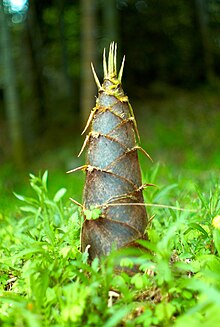 Talabaw soup | |
| Alternative names | Takapaw |
|---|---|
| Type | soup |
| Place of origin | Myanmar |
| Associated cuisine | Karen cuisine |
| Created by | Karen people |
| Main ingredients | bamboo shoot, snakehead fish |
| Ingredients generally used | Fish sauce, fish paste, rice powder, pepper powder, chicken powder, green chilli, okra, lemongrass, basil leaf, climbing wattle leaf, drumstick leaf, bean curd |
Talabaw (S'gaw Karen: တၢ်လပီၣ်, Burmese: တာလပေါ, Burmese pronunciation: [tàləbɔ́]; also transliterated as talapaw, lit. 'great soup' in Karen[1]), is a soup that originated in Karen cuisine. It is typically prepared with bamboo shoots, snakehead fish and basil leaves. A small amount of rice and some shreds of meat or seafood may also be added.[2][3][4][5]
The Karen traditionally used the soup to supplement rice, which was not cheaply available to them, consuming a large amount of soup with a small amount of rice in order to conserve the valuable rice.[1]
Talabaw is one of the most well-known soups in Myanmar, and widely considered to be the essential dish of Karen cuisine.[1]
Origin[edit]

Traditionally, the Karen people lived in wooded areas, only rarely visiting nearby towns. As, in lieu of buying food at the town market, they foraged in the forest where there was often plenty of bamboo especially during the monsoon season, bamboo shoots have become the primary and essential ingredient of the talabaw soup.[1]
Ingredients and preparation[edit]

Bamboo shoots are used either fresh or fermented; some recipes call for lacto-fermented shoots, which are usually used when bamboo is not in season.[1][6] The common preference is for giant bamboo whenever it is available, as it has a sweeter taste.[5] It can be cooked mainly with rattan buds, long pepper catkins, and unripe jackfruit.[7]
Typical additional ingredients are snakehead fish (and/or other types of seafood, or meat), lemongrass, drumstick leaves, basil leaves, climbing wattle leaves, okra, fish paste, bean curd, pepper powder, chicken powder, green chillies, fish sauce, tamarind juice, and rice powder along with salt.[1]
Preparation involves rinsing bamboo shoots in water several times before boiling the inner shoots.[8][6] Recipes typically call for cutting the shoots into thin slices, then giving them an extended boil to tenderize before adding other ingredients in a specified order for further simmering.[1]
A small amount of ground rice as well as shreds of meat or seafood may also be added. The soup is cooked until the rice and meat have become tender, and then chopped vegetables are added.[2][3][4] The soup is typically served with a small amount of cooked rice.[1]
There are multiple regional and family variations; some versions are as thick as stew and some are closer to a broth.[5]
Cultural promotion and tourism[edit]
The first Karen traditional food exhibition and talabaw cooking competition were held at Zwekabin Hall in Hpa-an on July 8, 2018, by Myanmar Restaurant Association and Kayin State Government. The event was designed to showcase traditional foods of the Karen people as tourist attractions. The Chief Minister Nang Khin Htwe Myint said that she wanted everyone visiting Kayin State to get into the habit of eating talabaw.[7]
See also[edit]
References[edit]
- ^ a b c d e f g h Duwun. "ကရင်မိသားစုတွေရဲ့ထမင်းဝိုင်းမှာ မပါမဖြစ်တာလပေါဟင်းတစ်ခွက်". Duwun. Retrieved December 27, 2022.
- ^ a b "Top Ten Kayin things to experience". The Myanmar Times. September 11, 2019. Archived from the original on August 27, 2022.
- ^ a b Kyaw, Min Ye (July 17, 2018). "Ethnic recipe: Karen Tarlapaw soup". Myanmore Magazine. Retrieved December 26, 2022.
- ^ a b "Traditional Foods of Kayin State, Myanmar". MyLocal Passion. Retrieved December 27, 2022.
- ^ a b c "ရာသီစာကရင့်ရိုးရာမျှစ်တာလပေါ့ဟင်း". BNI (in Burmese). Retrieved January 11, 2023.
- ^ a b Myanmar, MyFood (March 28, 2016). "ကရင်တာလပေါ ဟင်းချက်နည်း". MyFood Myanmar. Retrieved December 27, 2022.
- ^ a b "ပထမဆုံးအကြိမ် ကရင်ရိုးရာတာလပေါ့ဟင်းချက်ပြိုင်ပွဲ ဘားအံမြို့တွင်ကျင်းပ". Democratic Voice of Burma. Retrieved January 12, 2023.
- ^ Soe, MyintMyint (November 20, 2014). My Burmese Cookbook. AuthorHouse. ISBN 978-1-4969-9346-5.
Well, that’s interesting to know that Psilotum nudum are known as whisk ferns. Psilotum nudum is the commoner species of the two. While the P. flaccidum is a rare species and is found in the tropical islands. Both the species are usually epiphytic in habit and grow upon tree ferns. These species may also be terrestrial and grow in humus or in the crevices of the rocks.
View the detailed Guide of Psilotum nudum: Detailed Study Of Psilotum Nudum (Whisk Fern), Classification, Anatomy, Reproduction